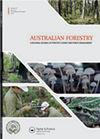斐济和汤加年轻的亚西Santalum yasi的产油量和成分
IF 1.2
4区 农林科学
Q3 FORESTRY
引用次数: 5
摘要
原产于斐济和汤加的檀香木Santalum yasi是这些国家具有重要经济潜力的树种。以育种计划为基础的种植业发展是产业发展的高度优先事项。收集有关心材发育、油产量和油成分的信息是该物种驯化和树木育种的关键步骤。采用气相色谱法和气相色谱/质谱联用法测定了86个檀香核心样品的出油率和组分。大多数(67)个岩芯来自S.yasi单株的下部树干,较小的S.album和S.album×S.yasi样本也普遍生长在斐济和汤加,并将S.austrocaledonicum包括在内进行比较。虽然这些树的树龄未知,但它们的树龄可能在10到20年之间。考察了溶剂提取油产量、油成分、树皮下和树皮上的下树干直径以及心材直径等性状之间的关系。产量变化很大(0.05–11.8%),仅与离地30厘米处的园下直径弱相关。油的产率和桑托尔油组分的组成百分比呈强正相关。对于产油量>1%w/w的树木,相对于S.album油的国际标准,其油成分通常是有利的,其中含有大量的santalol,特别是β-santalol。这项研究证实,20岁以下的S.yasi树的收获和遗传改良选择都可能是次优的,心材和油的开发不可靠。在具有已知遗传、受控环境和宿主的普通花园试验中,进一步研究心材和油的发育,无论是在单株内还是在基因型之间,都是当务之急。还建议为S.yasi制定一个国际标准,以支持该产品利基市场的增长。本文章由计算机程序翻译,如有差异,请以英文原文为准。
Oil yield and composition of young Santalum yasi in Fiji and Tonga
ABSTRACT Santalum yasi, a sandalwood native to Fiji and Tonga, is a tree crop of significant economic potential for these countries. Development of a plantation industry underpinned by a breeding program is a high priority for industry development. Gathering information on heartwood development, oil yield and oil composition is a critical step for the domestication and tree breeding of the species. Oil yield and composition were determined for 86 Santalum core samples using gas chromatography and combined gas chromatography/mass spectrometry. Most (67) cores were from the lower boles of individual trees of S. yasi, with smaller samples of S. album and S. album × S. yasi, both of which are also commonly grown in Fiji and Tonga, and S. austrocaledonicum was included for comparison. Although the ages of the trees were unknown, they are likely to have been between 10 and 20 years. Relationships among traits, including solvent-extracted oil yield, oil composition, lower bole diameters under and over bark, and heartwood diameter, were examined. Yield was highly variable (0.05–11.8%) and only weakly correlated with underbark diameter at 30 cm above ground. Oil yield and percent composition of santalol oil components were strongly positively correlated. For those trees with oil yields >1% w/w, the oil composition was generally favourable relative to the international standard for S. album oil, with large proportions of santalols, particularly β-santalol. The study confirms that both harvesting and selection for genetic improvement of S. yasi trees younger than 20 years old are likely to be suboptimal, with unreliable heartwood and oil development. Further study of heartwood and oil development, both within individual trees and among genotypes in common-garden trials with known genetics and controlled environments and hosts, is a high priority. The development of an international standard for S. yasi, supporting the growth of a niche market for the product, is also recommended.
求助全文
通过发布文献求助,成功后即可免费获取论文全文。
去求助
来源期刊

Australian Forestry
FORESTRY-
CiteScore
3.70
自引率
4.80%
发文量
15
审稿时长
>12 weeks
期刊介绍:
Australian Forestry is published by Taylor & Francis for the Institute of Foresters of Australia (IFA) for scientific, technical, and professional communication relating to forestry in the Asia Pacific.
 求助内容:
求助内容: 应助结果提醒方式:
应助结果提醒方式:


